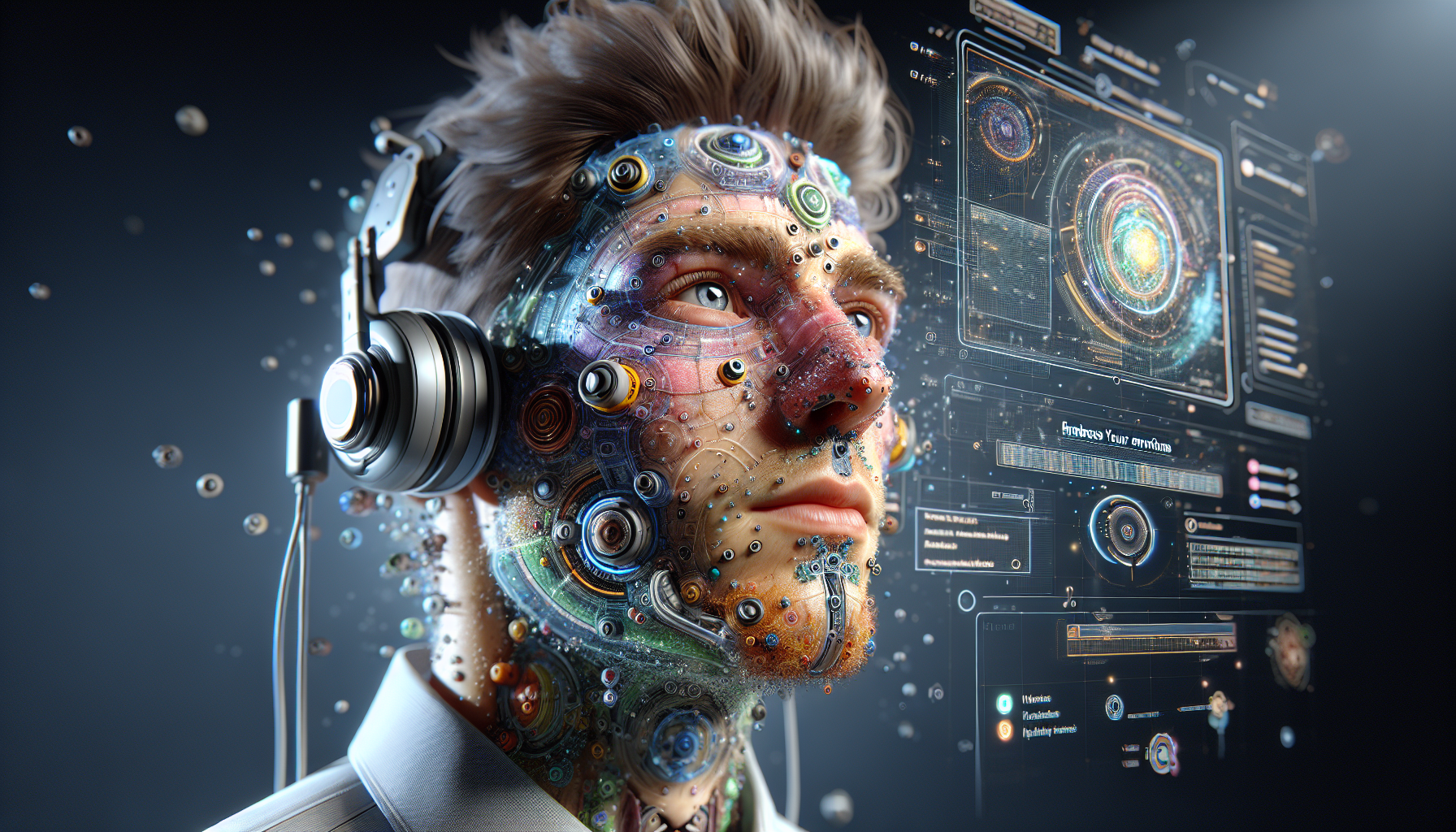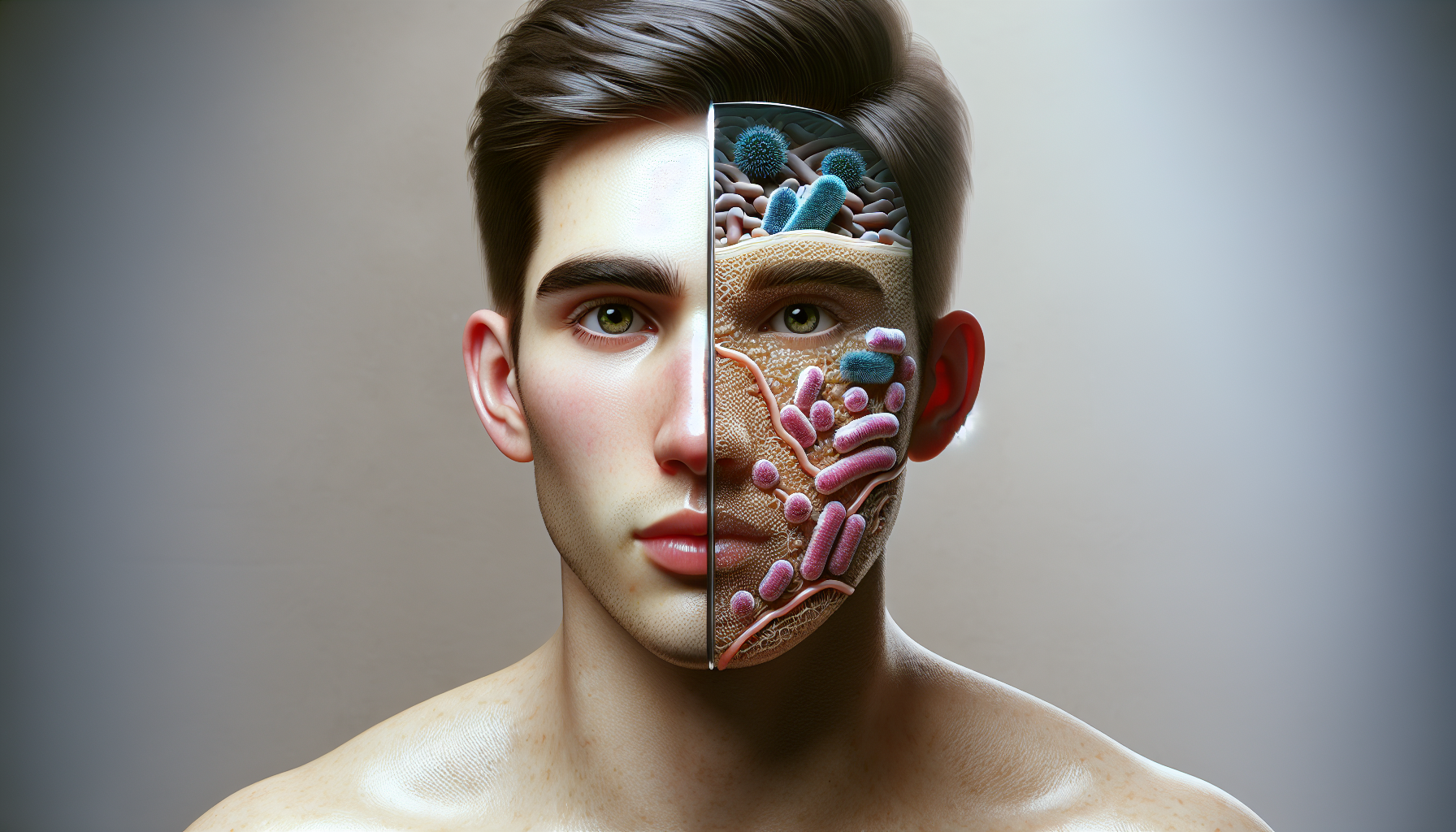In the ever-evolving realm of technology, where the boundary between reality and the virtual world blurs more with each passing day, a new frontier is emerging that promises to transform our digital experiences in unprecedented ways. Imagine a world where virtual interactions are indistinguishable from face-to-face conversations, where every subtle eyebrow raise and slight smirk is captured with stunning accuracy. Welcome to the revolutionary world of facial movement simulations in virtual reality (VR), a game-changing innovation that is poised to redefine how we perceive and interact with digital environments.
At the heart of this transformation is the quest for realism—an unyielding pursuit to create virtual experiences that resonate with the authenticity of real-world interactions. The journey begins with the intricate dance of facial expressions, those minute yet powerful cues that convey emotion, intent, and empathy in human communication. Until recently, the digital realm has struggled to replicate these nuances, often leaving users with a sense of detachment from their avatars. However, cutting-edge advancements in facial recognition technology and AI-driven simulations are bridging this gap, offering a more immersive and emotionally engaging VR experience than ever before.
In this article, we will delve into the intricacies of these groundbreaking facial movement simulations. We’ll explore how state-of-the-art algorithms and machine learning techniques are employed to capture the essence of human expression with unparalleled precision. From the technical marvels behind motion capture systems to the ethical considerations of using such intimate data, we’ll provide a comprehensive overview of the current landscape and future possibilities of this technology. Along the way, we’ll highlight real-world applications that showcase its potential, from revolutionizing gaming and entertainment to enhancing remote communication and education.
Join us on this fascinating journey as we uncover the profound impact of facial movement simulations on the VR experience. Whether you’re a tech enthusiast eager to stay at the forefront of innovation or a curious mind intrigued by the convergence of human emotion and digital interfaces, this exploration will offer valuable insights and provoke thoughtful reflection on the future of virtual reality. So, fasten your seatbelt and prepare to unleash your emotions in a world where technology and humanity converge in ways previously thought impossible. The future of virtual interaction awaits—are you ready to experience it? 🌟
The Evolution of Facial Movement Simulations in Virtual Reality
Virtual reality (VR) has transformed the way we interact with digital environments, providing immersive experiences that were once the realm of science fiction. A critical component of these experiences is the realistic simulation of human expressions, which has seen significant advances in recent years. The integration of sophisticated facial movement simulations into VR technology allows for a more authentic emotional engagement, bridging the gap between digital and human interactions. Let’s delve into how these simulations have evolved and their impact on VR experiences.
The Early Days of Facial Simulations
Initially, the representation of facial expressions in virtual reality was rudimentary, limited by the technology of the time. Basic avatars were unable to convey the subtleties of human emotions, relying on simple animations that lacked depth. This was partly due to limited computing power and the nascent state of motion capture technology. Early facial simulations were often static, with pre-defined expressions that could not adapt to real-time interactions.
Developers faced numerous challenges in attempting to create believable facial movements. The complexity of the human face, with its multitude of muscles and unique expressions, was difficult to replicate digitally. This often resulted in a disconnect between the avatar and the user’s emotional state, breaking the immersive experience VR aims to provide.
However, as technology progressed, so too did the capabilities of facial simulations. Innovations in motion capture, machine learning, and computer graphics began to pave the way for more advanced simulations. This laid the foundation for what would eventually become highly realistic and responsive facial animations.
Technological Advancements in Motion Capture
Motion capture technology has been pivotal in advancing facial simulations in VR. By tracking real human movements and translating them into digital form, developers can create avatars that move and express themselves in ways that mirror reality. Early systems were cumbersome, requiring actors to wear markers and suits in a controlled environment. Despite these limitations, motion capture provided a new level of detail in facial animations, capturing nuances that static models could not.
Today’s systems are far more sophisticated, using high-resolution cameras and sensors to capture every nuance of facial movement. Companies like Vicon and OptiTrack have developed systems that can track even the slightest twitch of an eyebrow or curl of the lip. This data is then used to drive complex algorithms that render these expressions in real-time, making avatars more lifelike than ever before.
Moreover, the integration of machine learning has further enhanced the capabilities of motion capture. Algorithms can now predict and adapt to a user’s expressions, learning from their unique facial movements to create a truly personalized experience. This advancement has been crucial in pushing the boundaries of what is possible in VR simulations.
Realistic Emotional Engagement in Virtual Reality
The ability to simulate realistic facial expressions has profound implications for VR, particularly in terms of emotional engagement. When users see their avatars reflect their emotions accurately, it creates a stronger connection to the virtual world. This is particularly important in applications such as gaming, social VR, and even virtual meetings.
Gaming and Interactive Storytelling
In the gaming industry, facial simulations enhance storytelling by allowing characters to express a wide range of emotions. Games like “The Last of Us Part II” and “Detroit: Become Human” have set new standards for emotional depth, using advanced facial animations to convey complex narratives. These expressions add layers of meaning to interactions, making players feel more connected to the story and its characters.
Interactive storytelling in VR benefits immensely from realistic facial simulations. Players can engage with characters on an emotional level, leading to more immersive and memorable experiences. This is further enhanced by VR’s ability to place users within the story, making them active participants rather than passive observers.
Developers are constantly exploring new ways to integrate facial simulations into gameplay, using them to drive narratives and influence player decisions. The potential for creating emotionally driven experiences in VR is vast, limited only by the creativity of developers and the technology at their disposal.
Social VR and Communication
Social VR platforms like Facebook’s Horizon and VRChat have revolutionized digital communication by incorporating realistic facial animations. These platforms allow users to interact in virtual spaces as avatars, with facial simulations capturing and conveying their emotions. This makes interactions more natural and engaging, breaking down the barriers of distance and digital communication.
The ability to express emotions accurately is crucial in social VR, where interactions are often driven by non-verbal cues. Facial simulations allow for subtler forms of communication, such as smiles, frowns, or raised eyebrows, which are essential for nuanced interactions. This has significant implications for remote work and virtual meetings, where conveying emotions can enhance understanding and collaboration.
As social VR continues to grow, so too will the demand for more advanced facial simulations. Companies are investing heavily in research and development to create avatars that are indistinguishable from real people, further blurring the line between physical and digital worlds.
Challenges and Future Directions
While the advancements in facial simulations for VR are impressive, there are still challenges to overcome. Ensuring the realism and responsiveness of avatars requires significant computational power and sophisticated algorithms. Additionally, achieving photorealism in avatars remains a complex task, as even the slightest discrepancies in facial expressions can break the illusion.
Computational Challenges
The processing power required to render realistic facial simulations in real-time is substantial. Developers must balance the need for high-quality animations with the limitations of current hardware. This often involves optimizing algorithms and using techniques like level of detail (LOD) to ensure smooth performance without compromising on realism.
Cloud computing and edge processing offer potential solutions to these challenges. By offloading some of the computational workload to cloud servers, developers can deliver high-quality simulations without overburdening local devices. This approach also enables more complex simulations, as developers can harness the power of distributed computing to enhance their algorithms.
Additionally, advancements in graphics processing units (GPUs) and artificial intelligence (AI) will play a crucial role in overcoming these computational challenges. As these technologies continue to evolve, they will enable more detailed and responsive facial simulations, further enhancing the realism of VR experiences.
Achieving Photorealism
Creating photorealistic avatars remains one of the most significant challenges in facial simulations. The human brain is highly attuned to recognizing faces, making even minor inaccuracies in digital representations noticeable. Developers must pay close attention to details such as skin texture, eye movement, and lighting to create convincing avatars.
To achieve photorealism, developers often use techniques like physically based rendering (PBR) and subsurface scattering to simulate the way light interacts with skin. These techniques require precise modeling and texturing, as well as advanced shaders to replicate the subtleties of human features.
Furthermore, the use of deep learning and AI-driven models can enhance the realism of facial simulations. By training models on vast datasets of human expressions, developers can create algorithms that mimic real-life facial movements with greater accuracy. This approach has the potential to revolutionize the field, enabling avatars that are virtually indistinguishable from real people.
The Role of AI and Machine Learning in Facial Simulations
Artificial intelligence (AI) and machine learning are increasingly important in the development of facial simulations for VR. These technologies offer new ways to capture and reproduce human expressions, leading to more responsive and adaptive avatars. By analyzing vast amounts of data, AI-driven models can learn to recognize and replicate subtle facial cues, enhancing the realism of simulations.
Machine Learning Models and Expression Recognition
Machine learning models are capable of analyzing facial movements and identifying patterns that correspond to different expressions. By training these models on extensive datasets, developers can create algorithms that recognize and reproduce a wide range of emotions. This enables avatars to respond dynamically to user inputs, creating more lifelike interactions.
For example, facial recognition software can detect a user’s smile and translate it into a corresponding expression on their avatar. This real-time feedback loop allows for seamless emotional engagement, making interactions in VR feel more natural and intuitive. As machine learning models continue to improve, they will enable even more sophisticated simulations, capturing the intricacies of human expressions with greater accuracy.
Additionally, AI can be used to personalize avatars, adapting their appearance and behavior based on the user’s preferences. This customization enhances the sense of presence in VR, allowing users to create avatars that truly reflect their personalities.
Real-time Adaptation and Personalization
The ability to adapt and personalize facial simulations in real-time is a significant advantage of using AI in VR. By analyzing user inputs and environmental factors, AI-driven models can adjust avatars’ expressions dynamically, enhancing the realism of interactions. This adaptability is particularly important in social VR, where users may engage with diverse groups and require avatars that reflect their current emotional state.
Personalization also extends to the customization of avatars’ physical features. Users can adjust aspects such as facial structure, skin tone, and hairstyle to create unique digital representations. This level of customization enhances the sense of ownership and identity in virtual environments, allowing users to express themselves authentically.
The integration of AI and machine learning in facial simulations represents a significant step forward in VR technology. As these technologies continue to evolve, they will unlock new possibilities for creating immersive and emotionally engaging virtual experiences.
Practical Applications and Implications
The advancements in facial movement simulations have far-reaching implications beyond gaming and social VR. These technologies are finding applications in various fields, from education and healthcare to training and entertainment. By providing realistic and responsive avatars, facial simulations enhance the effectiveness of VR as a tool for communication, learning, and skill development.
Education and Training
In educational settings, facial simulations can enhance the learning experience by providing interactive and engaging content. VR simulations can recreate historical events, scientific phenomena, or complex concepts, allowing students to explore and interact with them in a hands-on manner. Realistic facial animations add depth to these simulations, making characters and scenarios more relatable and impactful.
Training applications also benefit from advanced facial simulations. In fields such as medicine, law enforcement, and customer service, VR can provide realistic scenarios for skill development. By interacting with lifelike avatars, trainees can practice communication, problem-solving, and decision-making skills in a controlled environment. This approach enhances the effectiveness of training programs, preparing individuals for real-world challenges.
Healthcare and Therapy
Facial simulations have the potential to revolutionize healthcare and therapy by providing new ways to diagnose and treat patients. In therapeutic settings, VR can create immersive environments that help patients overcome phobias, manage stress, or improve social skills. Realistic facial expressions enhance these experiences by providing more authentic interactions with virtual characters.
Moreover, facial simulations can assist in medical training by providing realistic patient avatars for practice and assessment. Medical students can hone their diagnostic and procedural skills by interacting with virtual patients, enhancing their readiness for clinical practice.
Additionally, facial recognition technology can assist in diagnosing conditions such as autism or depression by analyzing patients’ facial expressions. This approach offers a non-invasive and efficient way to assess emotional and psychological states, providing valuable insights for treatment planning.
Conclusion: The Future of Facial Simulations in VR
As we look to the future, the potential of facial simulations in virtual reality is immense. With continued advancements in technology, we can expect even more realistic and responsive avatars that enhance the immersive experience. The integration of AI and machine learning will play a crucial role in achieving this goal, enabling avatars that adapt to users’ emotions and preferences.
The impact of facial simulations extends beyond entertainment, offering valuable applications in fields such as education, healthcare, and communication. By providing realistic and engaging virtual interactions, these simulations have the potential to transform how we learn, train, and connect with others.
As developers and researchers continue to push the boundaries of what is possible, we can look forward to a future where virtual reality experiences are indistinguishable from reality. The journey towards this goal is exciting, and the possibilities are limited only by our imagination.
| Features | Basic Facial Simulations | Advanced Facial Simulations |
|---|---|---|
| Technology | Simple animations | Motion capture, AI-driven models |
| Expression Range | Limited, pre-defined | Wide range, real-time adaptation |
| Applications | Basic avatars | Gaming, social VR, education, healthcare |
| Realism | Low | High, photorealistic |
Check out this video on YouTube to see how advanced facial simulations are transforming virtual reality experiences: Advanced Facial Simulations in VR – [YouTube Video Title]

Conclusion
In conclusion, the exploration of revolutionary facial movement simulations in virtual reality represents a significant leap forward in creating more immersive and emotionally engaging digital experiences. Throughout this article, we have delved into the technological advancements that make this possible, such as the integration of sophisticated algorithms and real-time facial tracking technologies. These innovations allow for the nuanced capture and replication of human emotions, thereby transforming the virtual reality landscape into one that more closely mirrors the depth and complexity of real-world interactions.
One of the key points discussed is the technical foundation of these simulations, which relies heavily on advancements in machine learning and artificial intelligence. These technologies enable the precise mapping of facial expressions, which are then translated into digital avatars with an impressive degree of accuracy. This breakthrough not only enhances user experience but also paves the way for more authentic social interactions in virtual environments. For more information on the technology behind this, you can explore sources like ResearchGate and IEEE Xplore.
Furthermore, we highlighted the potential applications of these simulations across various sectors. In gaming, for instance, players can now enjoy a more interactive and emotionally engaging experience, where characters react with realistic expressions. In the realm of social VR, these technologies foster deeper connections between users, as they can communicate with a level of emotional nuance previously unattainable in digital formats. Additionally, in professional training and education, these simulations offer realistic scenarios that can enhance learning outcomes by allowing users to practice and respond to authentic emotional cues.
The importance of these innovations cannot be overstated. As we continue to move towards a more digitally connected world, the ability to replicate human emotions in virtual spaces will play a critical role in shaping the future of communication and interaction. This technology has the potential to break down barriers, enabling people to connect on a more personal level regardless of geographical distance. By enhancing emotional expression and recognition in virtual environments, we not only improve user experience but also contribute to the development of a more empathetic digital society.
We also touched upon the ethical considerations surrounding these advancements. With great power comes great responsibility, and it’s crucial to ensure that these technologies are used ethically and inclusively. Developers must be mindful of privacy concerns and strive to create systems that protect user data and prevent misuse. This responsibility extends to creating inclusive technologies that accurately represent the diverse range of human emotions across different cultures and backgrounds. To dive deeper into the ethical implications, you may refer to articles on The Conversation and MIT Technology Review.
As we conclude, it’s important to reflect on the transformative potential of facial movement simulations in virtual reality. This technology is not just about enhancing digital interactions; it’s about bridging the gap between humans and machines, creating experiences that are as emotionally rich and meaningful as our real-world interactions. As you consider the possibilities, think about how this technology can impact your personal or professional life. Whether you’re a developer, educator, gamer, or simply an enthusiast of cutting-edge technology, there’s a place for you in this exciting journey towards a more connected and emotionally resonant digital future.
We encourage you to share your thoughts and experiences with these technologies. How do you envision the future of virtual reality with the integration of realistic facial movement simulations? What potential challenges or opportunities do you foresee? Your insights
Toni Santos is a visual explorer and microscopic storyteller who delves into the hidden aesthetics of microbial life. Through a fusion of scientific curiosity and artistic insight, Toni transforms the overlooked world of bacteria, fungi, and cellular forms into mesmerizing visual narratives—revealing the elegance, symmetry, and chaos that thrive at microscopic scales.
Rooted in a fascination with life forms too small to see yet too intricate to ignore, Toni’s work captures the bizarre beauty of microbial colonies, biofilms, and spore patterns. These images aren’t just representations—they are celebrations of the artistic intelligence encoded in nature’s tiniest architects.
With a background in visual design and bio-inspiration, Toni merges scientific imaging techniques with creative expression, transforming petri dish cultures, fluorescence microscopy, and microbial textures into works that provoke both wonder and contemplation.
As the creative force behind Vizovex, Toni offers curated visual studies, microbial-inspired designs, and essays that bridge art and microbiology—inviting viewers to reimagine what beauty means at the edge of perception.
His work is a tribute to:
The hidden geometries of living systems
The surprising elegance of microbial growth
The role of micro-life in shaping visual culture
Whether you’re a scientist, artist, or simply curious about the unseen world that sustains us, Toni opens a window into a universe where life writes poetry in colonies and patterns, one microbe, one frame, one breathtaking detail at a time.





